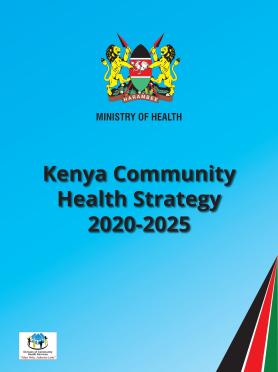Kenya Community Health Strategy 2020-25
Kenya Community Health Strategy 2020-25
The Republic of Kenya covers approximately 580,367 square kilometres. It is located in East Africa where it borders South Sudan to the northwest, Ethiopia to the north, Somalia to the east, Uganda to the west, and Tanzania to the south with the Indian Ocean on its south eastern coastal line (Figure 1). Kenya is administratively divided into 47 devolved County Governments led by a Governor and one National Government led by the President making a total of 48 Governments.
The population of Kenya is 47.5 million with 12.2 million households as per Kenya Population and Housing Census. The country’s average household size is 3.9 people. Its official languages are English and Kiswahili with the populace speaking a wide range of indigenous languages. Kenya has a young population with about 73% of the populace below 30 years of age and having an average life expectancy of 66 years as of 2019. Kenya is a lower-middle-income country (LMIC) and has the largest economy in east and central Africa. It has a robust agricultural sector with tea and coffee being its main cash crops. Tourism is also one of the major economic drivers. The GDP growth rate in Kenya has been above 5% for most of the last decade and the percentage of persons living below the poverty line in Kenya has declined from 46.8% in 2005/2006 to 36.1% in 2015/2016.
Kenya, like most countries across the world, is striving to attain the Sustainable Development Goal of Universal Health Coverage (UHC) by 2030. UHC aims to ensure that no one is left behind and that the entire population has access to quality healthcare services at a cost that does not lead them to financial hardship. The Government of Kenya recently made UHC one of its main priorities thus bringing Kenya closer to the goal of UHC.
In 2010, the people of Kenya promulgated a new constitution which guaranteed citizens the right to the highest attainable standards of health. The new constitution also devolved the provision of healthcare services to the 47 counties in Kenya. Since then, the counties have allocated financial resources for healthcare and supported the provision of healthcare services at the community level though with varying levels of commitment. It is clearly imperative that a strong political will and increased sustainable financial resources will be needed from both national and county governments to bring Kenya closer to achieving UHC with the implementation of contextualized interventions at the community level.

